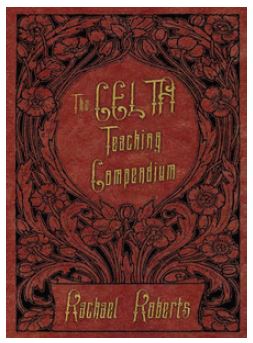The CELTA Teaching Compendium by Rachael Roberts
The CELTA Teaching Compendium by Rachael Roberts
978-1-370086-91-7 (Kindle edition ASIN B06XRGRMHB)

There are many books on the market aimed at helping CELTA candidates and English teachers who are new to the profession. Books like Jim Scrivener’s Learning Teaching, Penny Ur’s A Course in Language Teaching and Jeremy Harmer’s The Practice of English Language Teaching are thorough explorations of the theory and practice of English language teaching, covering everything from the teaching of the language systems (grammar, vocabulary, pronunciation, discourse) and the language skills (reading, writing, speaking, listening) to the different teaching methodologies and the theories behind them.
These books are often prescribed as pre-course reading for the CELTA trainee but, in my experience, very few trainees actually come onto a course having read even part of them. When asked why this is, some trainees say that trying to read these books pre-CELTA is like trying to read Greek before learning it. Once the course begins, it’s simply a question of time: particularly in the case of the intensive one-month CELTA, there is hardly any time for any serious reading.
Yet, the pressures of the teaching practice element of the course often see CELTA trainees finding themselves on Google every evening, searching for tips on lesson planning, error correction, classroom management and the other practical aspects of teaching an observed lesson. (It is a well-known fact that blogposts on CELTA get more hits than many other ELT-related posts.)
The CELTA Teaching Compendium is an e-book which puts together all the practical advice that a novice English teacher would need in a straightforward and easily-understandable way, while providing clear examples of best practice and common pitfalls. The book is divided into 33 sections, organised in alphabetical order, and each section is only one to two pages long, ensuring that the reader gets what they need without too much theory or backstory.
Readers are meant to dip in and out of the sections needed, using the contents page as a map with links to their areas of interest. The 33 sections include the problematic areas of a lesson plan, eg anticipated problems, learning objectives, stage aims, timing; classroom management techniques, eg building rapport, remembering names, instructions, fast finishers; and teaching techniques, eg drilling, checking understanding, eliciting and error correction.
The author is established ELT materials writer Rachael Roberts, the SIG coordinator of IATEFL’s MaWSIG (the group for materials writers) and an experienced teacher and teacher trainer with over 20 years’ experience. And this experience is evident throughout the book, as the tips and advice are clear and useful, without overcomplicating matters for the novice teacher. Yet the book avoids oversimplification and manages to be quite thorough in the practical advice it gives. In the section on concept checking questions for vocabulary, for example, the reader is told also to look out for false friends, words with different semantic boundaries and the different connotations of words; in the section exploring pace, Roberts warns the reader of the danger zones when dealing with pacing, eg warmers that go on for too long and teacher-centred whole-class feedback.
It would have been easy for a CELTA trainer to write a book solely based on her view of the CELTA and how she does things. But in the section on stage aims, Roberts recognises the fact that different CELTA tutors have different preferences and tendencies, and she acknowledges that some prefer the candidates to word their stage aims from the point of view of the learner, eg ‘For students to review and revise vocabulary from the previous lesson’, while others prefer the stage aims to be worded from the point of the view of the teacher, eg ‘To pre-teach words from a reading/listening text that might block comprehension’.
It was also reassuring to see a whole section dedicated to ‘wait time’, encouraging teachers to allow more thinking time before nominating a student to answer a question, and a section that provided a balanced view of the use of the mother tongue in the classroom, with the advice to use English when it is practical to do so but to recognise that there may be times when the use of mother tongue is more practical.
However, for me, the winning formula of this book lies in its tone. In some ways, The CELTA Teaching Compendium feels like a caring trainer’s diary entry to their trainee. Never once preachy, overly academic or condescending, this teacher trainer offers you insights into the practical aspects of CELTA by sharing her experience and advice in a friendly and helpful fashion, and regardless of which of the 33 sections you decide to dip into, it always feels like you’re speaking directly to a mentor who is letting you pick their brains about English language teaching. This is a worthwhile book for anyone undertaking the CELTA or Cert TESOL to have – or for anyone who is simply new to language teaching.
Chia Suan Chong
York, UK
Comments
Write a Comment
Comment Submitted